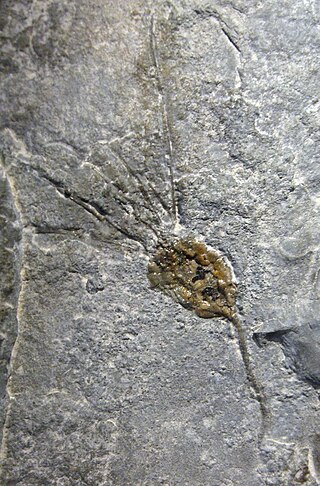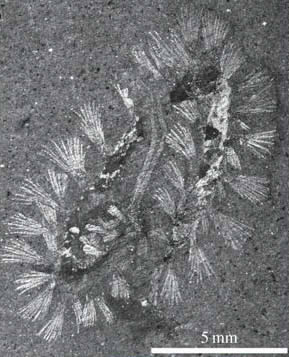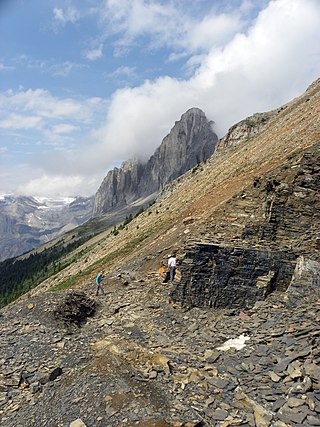Related Research Articles

The Burgess Shale is a fossil-bearing deposit exposed in the Canadian Rockies of British Columbia, Canada. It is famous for the exceptional preservation of the soft parts of its fossils. At 508 million years old, it is one of the earliest fossil beds containing soft-part imprints.

Marrella is an extinct genus of marrellomorph arthropod known from the middle Cambrian Burgess Shale of British Columbia. It is the most common animal represented in the Burgess Shale, with tens of thousands of specimens collected. Much rarer remains are also known from deposits in China.

Fasciculus vesanus is an extinct species of stem-group ctenophores known from the Burgess Shale of British Columbia, Canada. It is dated to 515 to 505 million years ago and belongs to middle Cambrian strata.

Kootenia is a genus of trilobites of the family Dorypygidae. 118 specimens of Kootenia are known from the Greater Phyllopod bed, where they comprise 0.22% of the community. Its major characteristics are that of the closely related Olenoides, including medium size, a large glabella, and a medium-sized pygidium, but also a lack of the strong interpleural furrows on the pygidium that Olenoides has.

Gogia is a genus of primitive eocrinoid blastozoan from the early to middle Cambrian.
The Kaili Formation(凯里組) is a stratigraphic formation which was deposited during the Lower and Middle Cambrian. The formation is approximately 200 metres (660 ft) thick and was named after the city Kaili in the Guizhou province of southwest China.

Leanchoilia is a megacheiran arthropod known from Cambrian deposits of the Burgess Shale in Canada and the Chengjiang biota of China.

Ogygopsis is a genus of trilobite from the Cambrian of Antarctica and North America, specifically the Burgess Shale. It is the most common fossil in the Mt. Stephen fossil beds there, but rare in other Cambrian faunas. Its major characteristics are a prominent glabella with eye ridges, lack of pleural spines, a large spineless pygidium about as long as the thorax or cephalon, and its length: up to 12 cm.

Odaraia is a genus of bivalved arthropod from the Middle Cambrian. Its fossils, which reach 15 centimetres (5.9 in) in length, have been found in the Burgess Shale in British Columbia, Canada.

Burgessia is a genus of arthropod known from the mid-Cambrian aged Burgess Shale of British Columbia, Canada. It is relatively abundant, with over 1,700 specimens having been collected.

Burgessochaeta is an extinct genus of polychaete annelids from the Middle Cambrian. Its fossils have been found in the Burgess Shale in British Columbia, Canada. A total of 189 specimens of Burgessochaeta are known from the Greater Phyllopod bed, where they comprise 0.36% of the community. Specimens have also been found at Marble Canyon. The genus was described by Conway Morris (1979) and re-examined by Eibye-Jacobsen (2004).

Actaeus is a genus of leanchoiliid megacheiran arthropod, containing the single species Actaeus armatus. It is known from a single specimen recovered from the Middle Cambrian Burgess Shale of British Columbia, Canada, and it may be actually a poorly preserved specimen of Alalcomenaeus. The specimen is over 6 cm long and has a body consisting of a head shield, 11 body tergites, and a terminal plate. It was named after Actaeus, first king of attica, and armatus a combination of greek and latin words to describe the frontal appendages of the species.
The fossils of the Burgess Shale, like the Burgess Shale itself, are fossils that formed around 505 million years ago in the mid-Cambrian period. They were discovered in Canada in 1886, and Charles Doolittle Walcott collected over 65,000 specimens in a series of field trips up to the alpine site from 1909 to 1924. After a period of neglect from the 1930s to the early 1960s, new excavations and re-examinations of Walcott's collection continue to reveal new species, and statistical analysis suggests that additional discoveries will continue for the foreseeable future. Stephen Jay Gould's 1989 book Wonderful Life describes the history of discovery up to the early 1980s, although his analysis of the implications for evolution has been contested.

The Burgess Shale, a series of fossil beds in the Canadian Rockies, was first noticed in 1886 by Richard McConnell of the Geological Survey of Canada (GSC). His and subsequent finds, all from the Mount Stephen area, came to the attention of palaeontologist Charles Doolittle Walcott, who in 1907 found time to reconnoitre the area. He opened a quarry in 1910 and in a series of field trips brought back 65,000 specimens, which he identified as Middle Cambrian in age. Due to the quantity of fossils and the pressures of his other duties at the Smithsonian Institution, Walcott was only able to publish a series of "preliminary" papers, in which he classified the fossils within taxa that were already established. In a series of visits beginning in 1924, Harvard University professor Percy Raymond collected further fossils from Walcott's quarry and higher up on Fossil Ridge, where slightly different fossils were preserved.
The Phyllopod bed, designated by USNM locality number 35k, is the most famous fossil-bearing member of the Burgess Shale fossil Lagerstätte. It was quarried by Charles Walcott from 1911–1917, and was the source of 95% of the fossils he collected during this time; tens of thousands of soft-bodied fossils representing over 150 genera have been recovered from the Phyllopod bed alone.

Oryctocephalus is a genus of trilobite known from the Middle Cambrian Burgess Shale. 24 specimens of Oryctocephalus are known from the Greater Phyllopod bed, where they comprise 0.42% of the community. This small- to medium-sized trilobite's major characteristics are prominent eye ridges, pleural spines, long genal spines, spines on the pygidium, and notably four furrows connecting pairs of pits on its glabella. Juvenile specimens have been found with only 5 or 6 thoracic segments and about one eighth of adult size, as well as about 2 mm wide.
The Mount Stephen trilobite beds are a series of fossil strata on Mount Stephen, British Columbia that contain exceptionally preserved fossil material. Part of the same stratigraphic unit as the Burgess Shale deposit, many non-mineralized parts are preserved; in addition, a high density of trilobite fossils is present.
Chancia is an extinct genus of Cambrian trilobite. It was a "fast-moving epifaunal detritivore" from Canada and the United States. Chancia was a particle feeder. Its major characteristics are a normal glabella but an enlarged cephalon due to a pre-glabellar field in front of the glabella, as well as developed eye ridges, medium-sized genal spines, and an extremely small pygidium.

The Cathedral Formation is a stratigraphic unit in the southern Canadian Rockies of Alberta and British Columbia, on the western edge of the Western Canada Sedimentary Basin. It is a thick sequence of carbonate rocks of Middle Cambrian age. It was named for Cathedral Mountain in Yoho National Park by Charles Doolittle Walcott, the discoverer of the Burgess shale fossils.
Ubaghsicystis is a genus of eocrinoid known from the mid Cambrian.
References
- ↑ Sprinkle, J.; Collins, D. (2006). "New eocrinoids from the Burgess Shale, southern British Columbia, Canada, and the Spence Shale, northern Utah, USA". Canadian Journal of Earth Sciences. 43: 303–322. Bibcode:2006CaJES..43..303S. doi:10.1139/E05-107.